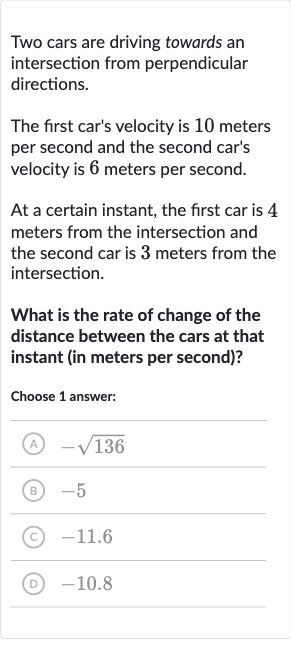AI tutor
Welcome to Bytelearn!
Let’s check out your problem:

Two cars are driving towards an intersection from perpendicular directions.The first car's velocity is meters per second and the second car's velocity is meters per second.At a certain instant, the first car is meters from the intersection and the second car is meters from the intersection.What is the rate of change of the distance between the cars at that instant (in meters per second)?Choose answer:(A) (B) (C) (D) .
Full solution
Q. Two cars are driving towards an intersection from perpendicular directions.The first car's velocity is meters per second and the second car's velocity is meters per second.At a certain instant, the first car is meters from the intersection and the second car is meters from the intersection.What is the rate of change of the distance between the cars at that instant (in meters per second)?Choose answer:(A) (B) (C) (D) .
- Draw Triangle: First, let's draw a right triangle where the legs represent the distances of the cars from the intersection, and the hypotenuse represents the distance between the cars.
- Calculate Initial Distance: Now, we calculate the initial distance between the cars using the Pythagorean theorem: .
- Find Rate of Change: So, which is .
- Derivative Formula: Taking the square root, the initial distance between the cars is , which is meters.
- Calculate Rate: Now we need to find the rate of change of this distance. We'll use the formula for the derivative of the distance with respect to time, which is the sum of the derivatives of the legs of the triangle.
- Negative Rate: The rate of change of the distance between the cars is the square root of the sum of the squares of their velocities, so rate = .
- Final Answer: Calculating that, we get which is .
- Final Answer: Calculating that, we get which is .So, the rate of change of the distance between the cars is meters per second. But since they are moving towards each other, it should be negative.
- Final Answer: Calculating that, we get which is .So, the rate of change of the distance between the cars is meters per second. But since they are moving towards each other, it should be negative.Therefore, the rate of change of the distance between the cars is meters per second, which is choice (A).
